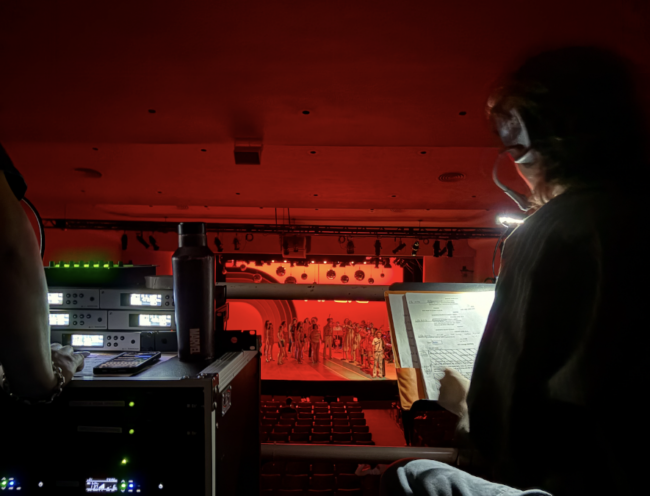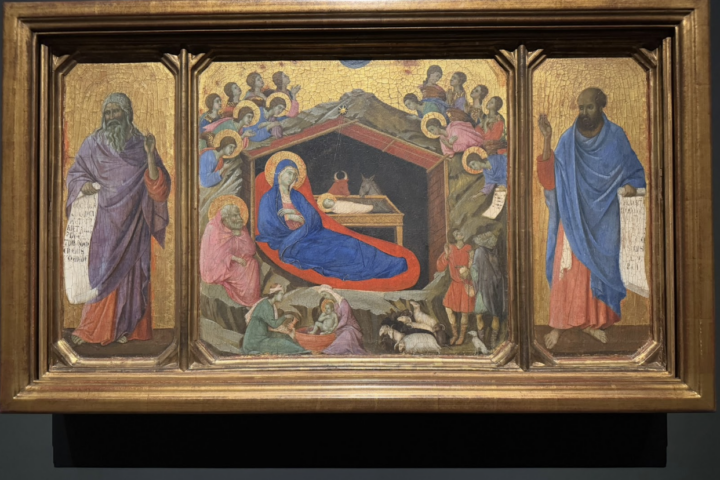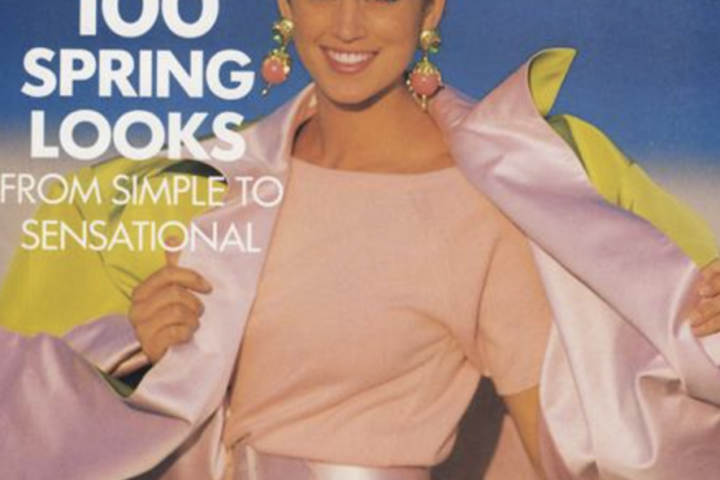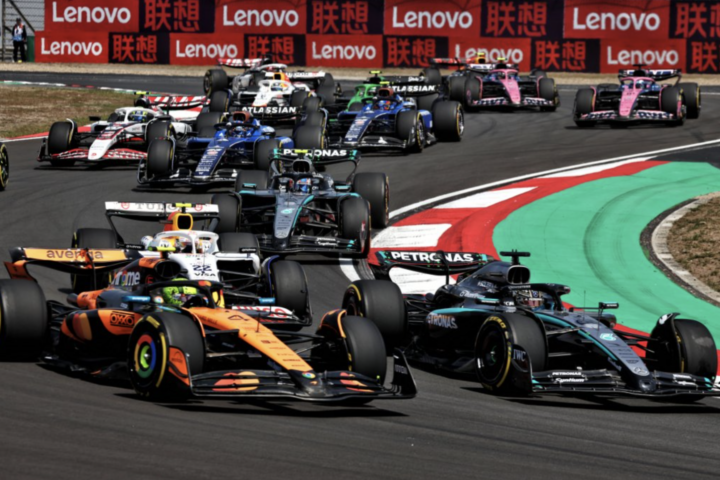Editors’ Note: Unless otherwise specified, all photo credits go to the author, Lily Saal
Band members quietly fine-tune their instruments, while actors shake out their jitters from the wings, both preparing for the incoming glaring stage lights.
Behind the lights, music, makeup, costumes, sound and set stands a passionate and skilled tech crew. Without them, the magic onstage would be impossible.
This year’s spring musical – “Pippin” – follows a young prince, the titular character, searching for self-fulfillment. With disco music, a colorful set design and constant breaks in the fourth-wall, the musical is complete fun, never taking itself too seriously.
The old Fieldston adage – “completely student run” – could not be more true in this year’s show. The tech crew employs students at every step; adults act as overarching directives, but students do all the necessary hands-on work.
Clare Mottola, Chair of the Theatre and Dance Department, directs the show, and Benji Gellman (Form VI) and Charlotte Ellis (Form IV) serve as her assistant directors.
Jon Schneidman, the music director and band conductor, works with a band of professional artists and Fieldston students: Meredith Metz (Form IV), Margot Stone (Form VI) and Jack Zirin-Hyman (Form VI).
“I love theater,” said Stone, who began doing tech crew in sixth grade before moving onstage as a band member. “I love starting a show I don’t know much about, fully immersing myself in it, and by the end, knowing the words to every song.”
Hannah Shafran (‘02) acts as technical director, overseeing Sam Harris (‘19) and Leonel Mendoza, the show’s lighting and sound directors, respectively. The tech trio works closely with the stage manager, Kol Riddle (Form VI).
“Once Hannah closes the [auditorium doors],” said Harris, “the show is Kol’s.”
Harris isn’t exaggerating: of the show’s 290 cues – from lighting to set shifts – Riddle calls every single one.
Riddle takes point from the sound booth (the balcony in the back of the auditorium), utilizing two assistant stage managers (ASMs) – Colombe Weinstein-Cambier (Form V) and Elliot Rubenstein (Form V). From there, the tech crew divides itself into jobs, covering different facets of the show.
The costumes/shift crew, made up of Ava Resnick (Form III), Jesse Gold (Form V) and Dov Schlanger (Form III), hunt through the school’s cleverly named “costume closet” for potential usable clothes, and move props/set pieces onstage. In one tense change during the show, the shift crew must quickly carry seven wooden blocks down the exit stairs, across the hallway, past the shop, up the stairs and to the other side of the stage. This is known in the Fieldston Theatre Department as a “runaround.”
Unlike typical theatrical productions, where shift crews wear all-black attire to remain “unseen,” Fieldston’s wear costumes, camouflaging perfectly with the bright disco outfits of the actors. In fact, the whole tech crew dresses up, even the remote ones in the lighting booth. Gold said, “It makes me feel like even more part of the show.”
Far up some rickety winding stairs, the lighting booth splits into two aspects: the lighting board and the spotlights. The board operators – Amelia Citron (Form VI), Mariela Alschuler (Form V) and Freya Matasar (Form V), alternate working the board, switching even during the performance. The spotlighters – Miranda Gluck (Form VI), Zeke Tesler (Form VI) and Leo Kanner (Form V), split up: two sit in the light booth, one in the sound booth.
It is a tech crew tradition to write on the walls of the lighting booth; everything from scribbled names to a full “Ode to the lighting booth.” Riddle, who pointed out signatures from 2011 and 1980 iterations of “Pippin,” said, “I find something new every time I’m up here.”
To access the sound booth, located just below the light booth, techies must climb an arduous ladder, which they nimbly accomplish with notebooks, water bottles, headsets, etc. in their hands. Perry Garon (Form V) and Michael Georgiades (Form V) operate the soundboard, which means adjusting every single cast member’s mic. As an actor enters and says a line, their mic volume increases, and as their moment on the stage dims, so does their mic’s volume.
The body mics crew – Marley Scotkin (Form VI), Brianna Bailey (Form V), John Keithline (Form IV) and Jake Siegel (Form IV) – attach and remove all the mics from the actors.
The tech crew’s journey begins in late November, as actors receive their roles and the rehearsals begin. The crew builds sets, creates props, makes costumes and prepares for the cast. A week and a half before opening night – Wednesday, February 26, this year – the crew sees the full show for the first time. From there, tech has one week to put it all together. Harris, the crew’s lighting director, said, “It’s a joyride at best and an interesting rollercoaster at worst.”
A week before the show, the cast and crew work at school from 9-6 PM, a mega-weekend event, intended to master every line and every cue. On Thursday, the group performs select scenes for the entire Upper School community during assembly and hosts an open-dress rehearsal, the first day of real audiences. On Friday, the middle school sees a sneak peek, and in the evening – Opening Night!
On Friday, call time is 5 PM, meaning the cast and crew must be at the auditorium/backstage. “Actors do whatever they want, but tech has a tradition,” said Riddle. Pre-call time, the tech crew competes in “tech-olympics,” where they play silly games, a Mario Kart tournament and put on a techie performance (where they attempt to perform the show). “It’s been a tradition for years,” said Riddle. “Since even before I was here.”
On Saturday, the entire cast and crew play a kickball game before the show, and participate in “Strike,” where they deconstruct and clean up the entire set after the show.
As they settle into their positions, adjust their headsets, check their “comms,” the crew steps into a well-oiled machine, nothing frantic, but everything sharp. To an untrained eye, their meticulous notes – stand by LQ31, Shift 11, etc. – seem like organized scribbles, but to the crew, it’s the glue holding the play together. They conduct their final checks: confirming prop placement, mic volume, spotlight position, then with the flip of a page, Riddle’s voice echoes through dozens of headsets:
“Spot one.”
“Go.”






